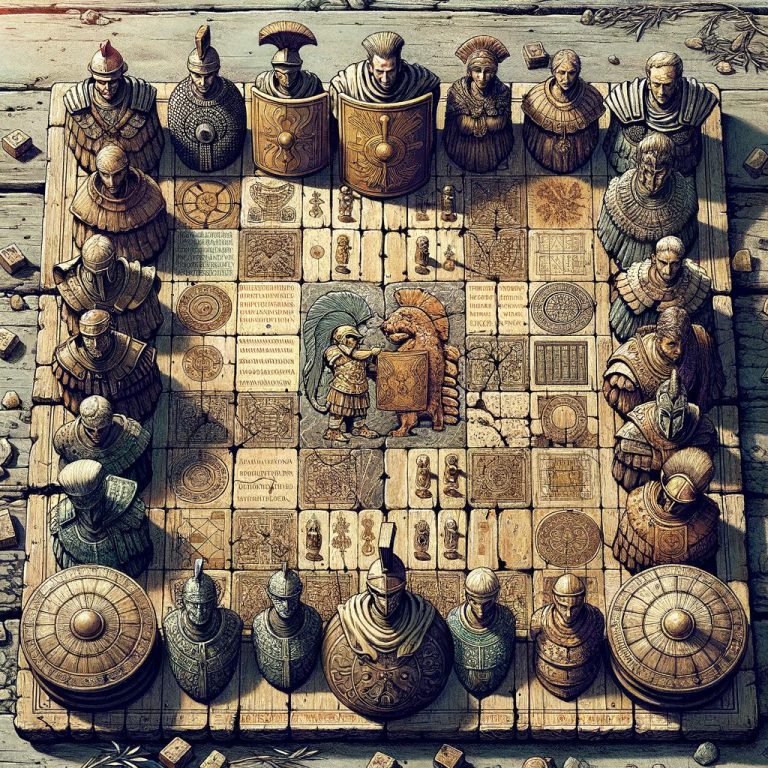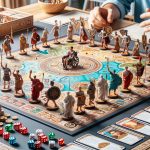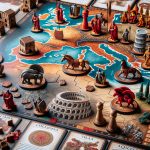Ancient Roman strategy board games have a rich history and hold a significant place in the world of gaming and strategic thinking. These games were not only a form of entertainment but also served as tools for sharpening one’s tactical abilities. The ancient Romans valued strategic thinking and problem-solving, attributes that are reflected in their board games.
The history of ancient Roman board games dates back centuries, providing insight into the cultural and social dynamics of the time. These games were played by people from all walks of life, from soldiers strategizing on the battlefield to nobles engaging in leisurely pastimes. They offer a glimpse into the mindset and competitive spirit of the ancient Romans.
Strategy played a crucial role in ancient Roman board games, shaping the way players approached each move and decision. Winning these games required foresight, adaptability, and cunning tactics. Players had to anticipate their opponents’ moves while devising their own plans to outmaneuver them. These games provided a platform for honing strategic skills and fostering healthy competition among players.
History of Ancient Roman Board Games
The history of ancient Roman board games dates back to the early civilization of Rome. Board games were not only a form of entertainment but also played a significant role in the social and intellectual development of the people. The Romans took inspiration from various civilizations they came into contact with, adapting and incorporating elements into their own board games.
Origins of Ancient Roman Board Games
Ancient Roman board games have their roots in the civilizations that came before them, such as the Greeks and Egyptians. One of the most well-known board games played by the Romans was Ludus latrunculorum, or “The Game of Mercenaries.” This strategy game involved capturing opponents’ pieces by surrounding them, similar to modern-day chess. Another popular game was Ludus duodecim scriptorum, a precursor to backgammon, where players had to move their pieces around a board according to dice rolls.
Role of Board Games in Ancient Roman Society
Board games were not just a pastime for the ancient Romans; they also held cultural and social significance. They were seen as tools for teaching strategy, critical thinking, and decision-making skills. Additionally, board games provided a way for people to interact and socialize, strengthening bonds within communities. The competitive nature of these games encouraged individuals to hone their strategic abilities and aim for victory, reflecting the values upheld in Roman society.
Importance of Strategy in Ancient Roman Board Games
The ancient Roman civilization placed a strong emphasis on strategy in their board games, considering it a vital skill for both entertainment and practical purposes. Strategy was not only valued in the context of leisure activities but also in military tactics and political decision-making. In fact, the strategic thinking required to excel in ancient Roman board games often mirrored the strategic planning needed for successful warfare and governance.
One of the most popular ancient Roman strategy board games that highlights the importance of strategy is Ludus Latrunculorum, also known as Latrunculi or simply latrones. This game involved capturing opponents’ pieces through strategic positioning and planning ahead to outmaneuver adversaries. The game simulated military conflicts, requiring players to anticipate their opponents’ moves while devising their own tactics to secure victory.
Another significant ancient Roman strategy board game that underscored the value of strategic thinking is Calculi. Played on a grid similar to modern chess or checkers boards, Calculi involved moving pieces to eliminate your opponent’s stones. Strategic decisions were crucial in this game, as players had to carefully consider each move’s implications on their position on the board and potential strategies employed by their opposition.
Overall, the significance of strategy in ancient Roman board games extended beyond mere entertainment; it served as a training ground for sharpening critical thinking, foresight, and tactical skills essential for success in various aspects of life within the ancient Roman society.
| Ancient Roman Board Game | Key Aspect |
|---|---|
| Ludus Latrunculorum | Capturing opponents’ pieces through strategic positioning |
| Calculi | Moving pieces strategically to eliminate opponent’s stones |
Types of Ancient Roman Strategy Board Games
In Ancient Rome, strategy board games were a popular pastime among people of all ages and social classes. These games were not only a form of entertainment but also served as a way to develop strategic thinking, decision-making skills, and tactical prowess. There were several types of ancient Roman strategy board games that have left their mark on history.
Ludus Latrunculorum
One of the most popular ancient Roman strategy board games was Ludus Latrunculorum, also known as Latrunculi or simply The Game of Thieves. This game was similar to chess in terms of strategy and gameplay but had its own unique characteristics. Players would use pieces representing soldiers to capture opponent’s pieces while protecting their own. The goal was to either immobilize the enemy’s forces or capture them all.
XII Scripta
Another well-known ancient Roman strategy board game was XII Scripta, which involved dice and markers on a special board with twelve spaces per player. The objective of the game was to move all markers from one end of the board to the other before your opponent did, using dice rolls to determine the number of spaces moved. Strategic decisions involved blocking opponents’ movements, creating opportunities for advancement, and cleverly positioning one’s own markers.
Tabula
Tabula was a game similar to modern backgammon and was immensely popular in Ancient Rome. Players used checkers on a specially designed board with two sets of 12 triangles each. The goal was to move all pieces off the board before the opponent by rolling dice and strategically moving one’s pieces around the board. Tabula required a mix of luck and skillful decision-making to outmaneuver opponents effectively.
Overall, these ancient Roman strategy board games provided intellectual stimulation and entertainment for people in society while honing their strategic thinking abilities. Playing these games offered a glimpse into the tactical mindset of ancient Romans and how they approached challenges both on and off the battlefield with calculated moves and cunning strategies.
Rules and Gameplay of Ancient Roman Strategy Board Games
This game involved two players, each with a set of pieces representing soldiers and a king. The goal was to capture the opponent’s pieces while protecting one’s own, demonstrating the importance of tactical positioning and foresight.
Another popular ancient Roman strategy board game was Ludus Duodecim Scripta, which translates to “Game of Twelve Lines.” This game involved rolling dice to move pieces around the board and ultimately bear them off. Players had to strategize not only on how to move their pieces efficiently but also on blocking their opponents’ progress. This game required a combination of luck and skill, making it an exciting challenge for players.
Apart from these specific games, the ancient Romans also enjoyed playing other strategy board games like Tabula (similar to modern-day backgammon) and Timea at Areia (a version similar to tic-tac-toe). These games varied in complexity and gameplay but all shared the common theme of requiring strategic thinking and planning to outwit one’s opponent. The rules were often simple yet provided ample room for strategic maneuvering, making them engaging for players of all ages and backgrounds.
Comparison to Modern Strategy Board Games
Ancient Roman strategy board games have left a lasting impact on the history of board games, influencing modern strategy board games in various ways. While the ancient Romans primarily played games like Ludus Latrunculorum and Ludus Duodecim Scriptorum, their strategic elements can be seen in popular contemporary games such as Chess, Settlers of Catan, and Risk. These modern board games incorporate similar tactics of planning, foresight, and adaptability that were essential in ancient Roman strategy board games.
One key aspect where ancient Roman strategy board games have influenced modern counterparts is the level of strategic thinking required to outmaneuver opponents. Games like Ludus Latrunculorum involved capturing pieces by surrounding them with your own pieces, akin to strategies used in Chess where players aim to checkmate their opponent’s king.
This element of spatial awareness and tactical planning can be traced back to the gameplay of ancient Roman board games, showcasing how these strategies have stood the test of time.
Moreover, the emphasis on resource management and risk assessment seen in ancient Roman strategy board games can also be found in contemporary board game mechanics. Games like Risk challenge players to expand their territories while calculating potential risks and rewards-a principle that aligns with the strategic decision-making process evident in Ludus Duodecim Scriptorum.
By recognizing the parallels between ancient Roman strategy board games and modern counterparts, players can gain a deeper appreciation for the enduring legacy of these historical games.
| Ancient Roman Strategy Game Element | Modern Board Game Equivalent |
|---|---|
| Spatial Awareness and Tactical Planning | Chess |
| Resource Management and Risk Assessment | Risk |
Influence of Ancient Roman Strategy Board Games in Today’s Society
Ancient Roman strategy board games have left a lasting impact on modern society, influencing various aspects of culture and entertainment. The strategic thinking and problem-solving skills required to excel in these ancient games have translated into valuable life lessons that are still relevant today. Whether it is in business negotiations, military tactics, or even educational settings, the principles learned from playing ancient Roman strategy board games are applicable in many real-life scenarios.
Some key ways in which ancient Roman strategy board games have influenced today’s society include:
Overall, the influence of ancient Roman strategy board games in today’s society underscores the enduring appeal of these classic pastimes. By rediscovering and embracing these traditional games, individuals can not only enhance their strategic thinking abilities but also connect with a rich cultural heritage that continues to shape contemporary perspectives on entertainment and recreation.
Popular Ancient Roman Strategy Board Games to Play Today
If you are a history enthusiast or a strategy game lover, exploring ancient Roman strategy board games can be a fascinating experience. These games offer not only entertainment but also a glimpse into the strategic thinking of the ancient Romans. Here are some popular ancient Roman strategy board games that you can still play today:
1. Latrunculi: Also known as “Ludus Latrunculorum,” Latrunculi was a game similar to chess or checkers but with its unique twists. Players would move pieces around the board strategically to capture their opponent’s pieces. The game required careful planning and foresight, much like modern-day chess.
2. Duodecim Scripta: This ancient Roman game was played on a board with three rows of twelve squares each. Players had to move their pieces around the board according to dice rolls, aiming to get all their pieces off the board before their opponent. Strategic placement and an element of luck made Duodecim Scripta an engaging game for players of all ages.
3. Tabula: Tabula was similar to modern backgammon, where players moved their pieces based on dice rolls and tried to bear them off the board first. The game involved both skillful positioning of pieces and calculated risk-taking, making it a favorite pastime among ancient Romans.
Playing these ancient Roman strategy board games can be not only enjoyable but also educational, offering insights into the strategic thinking and leisure activities of this ancient civilization. Whether you prefer tactical gameplay or luck-based challenges, exploring these games can provide hours of entertainment while connecting you with history in a unique way.
Tips and Tricks for Mastering Ancient Roman Strategy Board Games
When it comes to mastering ancient Roman strategy board games, there are a few key tips and tricks that can help improve your gameplay. One of the most important strategies is understanding the specific rules and objectives of each game. By taking the time to familiarize yourself with the intricacies of games like Ludus Latrunculorum or Ludus Duodecim Scriptorum, you can develop a more strategic approach to playing.
Another essential tip is to anticipate your opponent’s moves and think several steps ahead. Just like in modern strategy board games, planning and adapting your strategy based on your opponent’s moves is crucial for success in ancient Roman games. By paying attention to patterns and predicting possible outcomes, you can stay one step ahead and outsmart your opponents.
Practice makes perfect when it comes to mastering ancient Roman strategy board games. The more you play, the better you will become at recognizing optimal moves and developing winning strategies. By honing your skills through regular gameplay and learning from both victories and defeats, you can become a formidable player in these historical games. Embrace the challenge, experiment with different tactics, and never stop striving to improve your gameplay in ancient Roman strategy board games.
In addition to practicing regularly, seeking out resources such as books on ancient Roman gaming strategies or online forums dedicated to these games can provide valuable insights and tips for honing your skills. Engaging in discussions with fellow enthusiasts and learning from experienced players can offer new perspectives and strategies that can enhance your gameplay.
By combining dedication, strategic thinking, practice, and a willingness to learn from others, you can increase your chances of mastering ancient Roman strategy board games successfully.
Conclusion
In conclusion, the enduring legacy of ancient Roman strategy board games continues to captivate enthusiasts and scholars alike, offering a fascinating glimpse into the strategic thinking and entertainment preferences of ancient civilizations. These games have stood the test of time, revealing insights into societal values, intellectual pursuits, and leisure activities of the era. While modern board games have evolved and diversified, the foundational principles of strategy and gameplay found in ancient Roman board games remain relevant and engaging.
The significance of strategy in ancient Roman board games cannot be overlooked. These games served not only as sources of entertainment but also as tools for honing strategic thinking, decision-making skills, and tactical planning. The competitive nature of these games encouraged players to think critically, anticipate opponents’ moves, and adapt their strategies accordingly. In essence, ancient Roman strategy board games were more than just pastimes; they were vehicles for mental stimulation and skill development.
As we reflect on the history, rules, gameplay, and types of ancient Roman strategy board games discussed earlier in this article, it becomes evident that these timeless classics continue to inspire intrigue and fascination in contemporary society. The enduring appeal of these games lies in their ability to challenge players intellectually while providing a source of enjoyment and social interaction.
Whether you are a seasoned player or a newcomer to the world of ancient Roman strategy board games, exploring these historic pastimes can offer a rewarding experience that transcends cultural boundaries and time periods.
Frequently Asked Questions
What Board Games Did the Romans Play?
The Romans enjoyed playing a variety of board games, with some popular choices being Ludus latrunculorum, Tabula, and Duodecim Scripta. Ludus latrunculorum involved strategy and was played on a square board.
What Is the Oldest Strategy Board Game?
The oldest known strategy board game is Senet, dating back to ancient Egypt around 3100 BC. It was a game of chance and strategy played on a grid of 30 squares arranged in three rows of ten.
What Is the Most Famous Strategy Board Game?
The most famous strategy board game is undoubtedly Chess. Originating in India during the Gupta Empire, Chess has become a worldwide phenomenon with millions of players competing in tournaments and studying the game’s complexities for centuries. Its strategic depth and rich history have solidified its place as a classic board game.

I love playing all kinds of games – from classics like Monopoly to modern favourites like Ticket to Ride.
I created this blog as a way to share my love of board games with others, and provide information on the latest releases and news in the industry.





